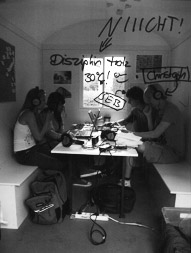Working in a Field of Tensions 9:
Documentation of Arts Mediation and its Challenges
“What has always been key with respect to representation is how and why someone is being ‘represented’, ‘depicted’, ‘presented’ or ‘rendered’, what purpose that representation serves and what remains excluded, i.e. what has been rendered invisible through visibility. It is a question of the power inherent in the act of putting forth to be seen.” (→ Sturm 2001)
Documentation of cultural mediation activities often falls within the responsibility of cultural mediators and causes them, willingly or otherwise, to engage with questions of modes of representation and their effects. To depict an occurrence, one is forced to come to terms with issues relating to what description or which photograph is “eloquent”, “appropriate” or “good enough”. However, one can always adopt a more profoundly reflexive approach to documentary practices by asking oneself certain questions: Who makes decisions about the forms used to render things visible? What interests underlie those decisions? Who is being depicted and identified, and how? What is shown repeatedly and what is left out completely? Who, or what, remains invisible and unidentified due to the method and style of the documentation? And how does that which is shown become “evident” and acquire the force of proof? Fundamental to this → critical perspective on representation is the awareness that documentation does not directly depict cultural mediation. Instead, it shows and produces objects, persons and projects in a certain way. Documentation is based on the active process of selecting, designing, and showing, and thus places a powerful and challenging responsibility in the hands of those doing the documenting.1
To explore the production of meaning and normality in the depiction of cultural mediation, we will start by looking at an example of the documentation of a family day of the kind featured in the cultural mediation programmes of many museums. Certain motifs appear pre-ordained and appropriate for the documentation of such events, others seem inappropriate and remain undocumented. For instance, the pre-event preparations and post-event clean up seldom figure in the pictures taken of family days, one seldom sees impatient or quarrelling children, very rarely do we see the tears spilled after an unsuccessful creative attempt, interruptions and waiting times, bored parents or stressed mediators. The omission of certain aspects is a central part of the representation work and production of meaning, in the same way that the repeated depiction of other aspects is. Which motifs are selected for a documentation, and shown over and over again, is primarily a question of institutionalized rules and routines of showing which aim at suitability for a specific purpose. The purpose may be that of addressing the “family” as a target group, that of framing the museum as a venue for a special type of recreational activity, or that of testifying to the successful implementation of a project for its sponsors. These depictions, normally intended to be clearly recognizable and devoid of ambiguity, build a limited repertoire of standard motifs shown over and over again with slight variations. 2
In the context of a family day, we might find the depiction of two adults and two children standing next to each other, their backs to the camera and their bodies and eyes directed toward a large painting. It might be a guided tour for children and adults with a mediator pointing to a work of art; or it might be a studio scene, showing a child and an adult sitting at a paint-stained table and concentrating on an object they are making. These depictions are easy to decode as “art mediation” and “family” and they are often found as representations of a family day in the documentation of arts mediation. Yet the repeated display of the expected reinforces again certain meanings and conceptions.

Even when this typical art mediation image is not explicitly labelled with “family day”, there is no question but that this “is” a family. The group of people is identified as a family automatically. The fact that we perceive and recognize groups in this way is not inherent to human understanding though, it is the effect of powerful processes at play in repeated identification in the same style and manner in a wide variety of settings.3 This repetition establishes the perception of certain constellations of people as families and by doing so creates images of “real” and “proper” families.4 However, this also results in the creation of boundaries defining what is normal, and thus certain constellations of people and behaviours are made identifiable as abnormal families or even denied that identity altogether – which can have serious consequences for their social, societal or legal recognition and thus the stability of their future. 5
The depiction and identification of families in the context of cultural mediation documentation is thus tied up with the powerful and, at least potentially, harmful re/production of normality, which must be taken into account during the documentation process. What can one safely do to depict cultural mediation? Would it be better to stop showing people at all in the context of family days? Selecting images showing only tools, rooms, products or the traces of cultural mediation work would certainly be one option. That would not stop the normalized depiction of families from continuing elsewhere. However, taking this perspective further, the documentation of art mediation represents a field of opportunity for disrupting the dominant practices of showing and labelling. For example, one can show people in the context of a “family day” who “normally” would not represent a family or one can develop alternative depictions to which the label is not obviously attached. 6
Yet many images are more ambiguous than the depiction of a “normal family”, for instance, which is why captions are often added to the photographs selected for use in documentation. Captions are placed above or below the pictures when the authors want to highlight or clarify something. What is important or significant about the picture is made explicit: who or what are we supposed to see in the picture? When and in what context was the picture taken? What is it intended to show? This restricts the flux of meaning; the ambiguity of photographs is limited, certain ways of reading them are reinforced and certain statements highlighted. A specific visibility and identity is thus attributed to the people and situations that are shown and named.
One could see the photograph below and the comments written on it, which were created in the context of the cultural mediation project “micro-fiction” – Ist Demokratie gerecht?” [Is democracy fair?] (2009) as an example of an alternative approach to captioning.7
The cultural mediators came up with the idea of having the participants write comments on the photographs taken during the project. Participants could fill in aspects which were missing or invisible but which they thought were significant.

Foto © Henrike Plegge,
Stephan Fürstenberg
This assignment to add comments represents an attempt during micro-fiction** to integrate the people depicted within the documentation process for “their” project. At the same time, documenting an event collectively offers a potential way to counter the unequal distribution of power between documenters and their subjects. 8 Instead of concentrating only on unilateral statements about the project and its participants issued by the representatives of an institution, one can create conditions and structures which open opportunities for creativity and for transferring the power to decide to all of those involved, thus allowing multiple voices to express themselves in the documentation. This could be done by passing the camera around within the group to document the course of a project, or meeting to review and select the pictures to be used in a publication at the project’s end or – as in the example above – collectively discussing and appending comments to the photographs which have been produced.
Having participants write comments on the photographs created some scope for them to contribute or register objections at the documentation level and in doing so created a place for brief moments of friction (see Mörsch 2005) which are often omitted in documentation and which make cultural mediation the unique processes that they are. In this example, these moments are the stifling heat in the trailer during the audio editing, the names of the young people or the joking reference to discipline added by the students. These aspects do not enter into the “anticipated” depiction of the project, as, they do not obviously serve a representative function.
Intervention into the photographs like this should not be done in the pursuit of making visible all that is unseen. That would be impossible, if only because documentation is not a synonym for transparency: documentation is always a process based on the interplay between visibility and invisibility. However the addition of comments in the micro-fiction** project can be understood as a direct reference in the document to the fact that some elements are left invisible and unidentified in the project documentation. Thus the very style and form of the project documentation encourage people to think about documentation.
It would not be at all accurate to say that the scope for alternative approaches and creative activity in documentation work is so restricted that it permits only the recording, selection and (again) presentation of what is expected 9, however it is true that the power to make decisions about what aspects of cultural mediation are put forth to be seen lies only partially with those who do the documenting. The repeated lacunae in what is visible and repeated failure to identify certain details in documentation processes can often be traced to the various interests, representational standards and institutionalized rules as well as routines associated with the presentation of cultural mediation. This also emerges in the presentation of micro-fiction**: on the project initiators’ webpage only photographs, without the comments, are shown. 10 In this form of depiction, the “brief moments” remain invisible to the viewers. Visualizations there function more as a sort of “photographic evidence”, furnishing evidence that the project has taken place by providing a photographic record of the people and their activities. The use of photography, an “objective” documentary medium, furthers this purpose of documentation by conveying the impression of that events are being depicted directly as they occur.
A glance through the archives of cultural mediation departments makes it clear that documentation is an area in which the mediators engaged in documentation work can input their own ideas and interests and that it is one which leaves scope open for transformative modes of representation, using experimental recording methods, participative documentation processes and a project- and process-oriented selection of documents along with a representation-critical depiction. Beyond the “documentarist” approach of legitimization and repetition of expected content, the documentation area offers the possibility of designing surprising and challenging modes of representation that tap into the potential of the medium being used and combine it with other recording processes. However, “other” representations can also be created by shifting the focus onto the ostensibly inappropriate or insignificant motifs and moments outside of the realm of the anticipated, which have gone undocumented up to now.
Inadequate access to financial or personnel resources and insufficient authority to determine design or make decisions on the part of the mediators engaged in documentation work certainly put limits on the methods they can use to creating transformative documentation, but these are not the only factors at work. The conflicts of interests and aspirations associated with the depiction of cultural mediation manifest in their documentation also play an important role.
For instance, the desire to work with participants to produce a challenging and reflexive documentation of a project can collide with the desire to lodge evidence which testifies to successful work, in order to justify a past expenditure and future resource allocation. It may collide with the representational aspirations of one’s own institution, which is also interested in using the documentation of “its” cultural mediation work as a vehicle to present itself in the appropriate light. In this field of tension, furnishing documentation that is transformative will continue to pose a challenge, both daunting and worthwhile, for cultural mediatiors.

Foto © Henrike Plegge,
Stephan Fürstenberg
1 Sociologist and art theorist Stuart Hall describes representation as “active work of selecting and presenting, of structuring and shaping: not merely the transmitting of an already-existing meaning, but the more active labour of making things mean.” (Hall 1982, p. 64).
2 See also the findings of the SNSF research project “Showing Gallery Education” 2011–2013, → http://iae.zhdk.ch/iae/deutsch/forschung-entwicklung/projekte/kunstvermittlung-zeigen-repraesentationen-paedagogischer-museumsarbeit-im-feld-der-gegenwartskunst-laufend [22.2.2013]
3 E.g. in the spheres of the mass media, medicine, politics, science, the arts and culture or law – what Stuart Hall calls the “regimes of representation”.
4 See the poster “When they say family” of the public art project “Hey Hetero!” (2001) by Deborah Kelly and Tina Fiveash, which frames characteristics like whiteness, absence of disability, middle-class or a peaceful togetherness as attributes of the standard image of a family while critically underlining the normality and regularity of a heterosexual couple in a family setting. See → http://tinafiveash.com.au/hey_hetero_when_they_say_family.html [21.09.2012]
5 For example, teenage mothers and fathers, parents with physical or cognitive impairments or non-heterosexual partnerships.
6 For an inspiring example of cultural mediation work that challenges normality and assumptions about “families” see the project “Familienstudio Kotti – oder die Möglichkeit sich gemeinsam neu zu erfinden” [Family studio Kotti – or the possibility of reinventing ourselves collectively] realized by Bill Masuch as part of the Kunstcoop© group of projects. The project challenged and shifted the dominant images of families by creating photographic portraits of new “families” which were formed spontaneously on a sidewalk in Berlin, made up of people who happened to pass by; its effectiveness is in great part due to the use of painted backdrops emphasizing the artificial nature of “family situations” and their depiction (see NGBK 2002, p. 131 f.).
7 A partnership between the art and media technology centre in Karlsruhe, ZKM | Zentrum für Kunst und Medientechnologie and the secondary school Windeck Gymnasium Bühl under the initiative “Cities in the Year of Science”. Concept, realization and photo rights: Henrike Plegge, Stephan Fürstenberg.
8 Questions associated with a critical approach to representation in this context: “Who represents and who is represented? Who is visible and acknowledged? Who is not visible? Who is entitled and able to represent herself? Who is entitled and able not to represent herself? Who is authorized to speak for others and represent others? Who is considered the legitimate spokesperson for a group? Who is considered not to be a legitimate spokesperson?” (Broden, Mecheril 2007, p. 14); → http://pub.uni-bielefeld.de/download/2306439/2306444 [2.1.2013], see Resource Pool MFV0902.pdf.
9 In this context the conditions can be far less restrictive than, for instance, would be the case in connection with “reports” for sponsors, who often insist on fixed report formats.
10 See → http://www.staedte-im-wissenschaftsjahr.de/2009/tp_karlsruhe_schuelerrecherche.html [21.9.2012]
Literature and Links
Literature:- Bourdieu, Pierre: Die feinen Unterschiede. Kritik der gesellschaftlichen Urteilskraft, Frankfurt a.M.: Suhrkamp, 1982
- Broden, Anne; Mecheril, Paul: “Migrationsgesellschaftliche Re-Präsentationen. Eine Einführung”, in: Broden, Anne; Mecheril, Paul (eds.): Re-Präsentationen. Dynamiken der Migrationsgesellschaft, Düsseldorf: IDA-NRW, 2007
- Hall, Stuart: “The Rediscovery of Ideology: Return of the repressed in media studies”, in: Gurevitch, Michael, et al. (eds.): Culture, Society and the Media, London: Methuen, 1982, pp. 56–90
- Mörsch, Carmen: “Application: Proposal for a youth project dealing with forms of youth visibility in galleries”, in: Harding, Anna (ed.): Magic Moments. Collaborations between Artists and Young People, London: Black Dog, 2005, pp. 198–205
- NGBK Berlin (pub.): Kunstcoop©, Berlin: Vice Versa, 2002
- Sturm, Eva: “In Zusammenarbeit mit gangart. Zur Frage der Repräsentation in Partizipations-Projekten”, in: Kulturrisse no. 2, 2001, not paginated; [21.9.2012]; → MFV0901.pdf
- Year 11 of Windeckgymnasium, Karlsruhe; ZKM Karlsruhe: “Ist Demokratie gerecht?”: http://www.staedte-im-wissenschaftsjahr.de/2009/tp_karlsruhe_schuelerrecherche.html [21.9.2012]
- Kelly, Deborah; Fiveash, Tina: “Hey Hetero”, 2001 [21.9.2012]










